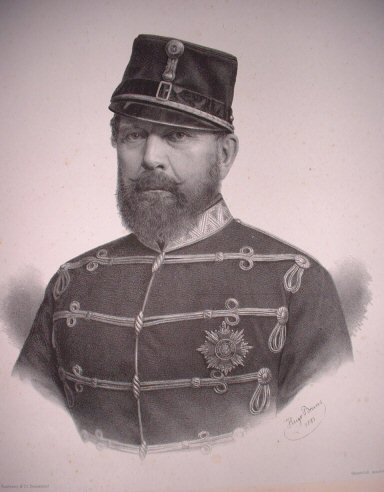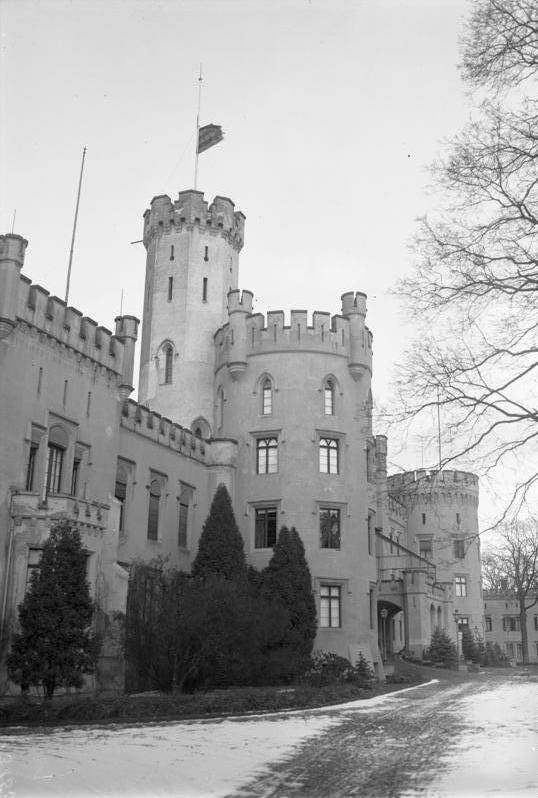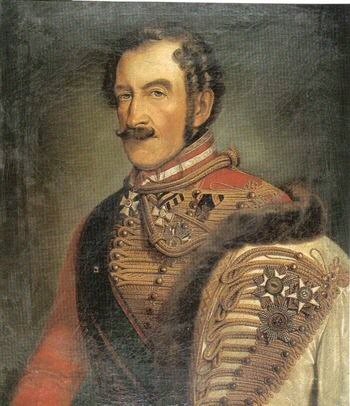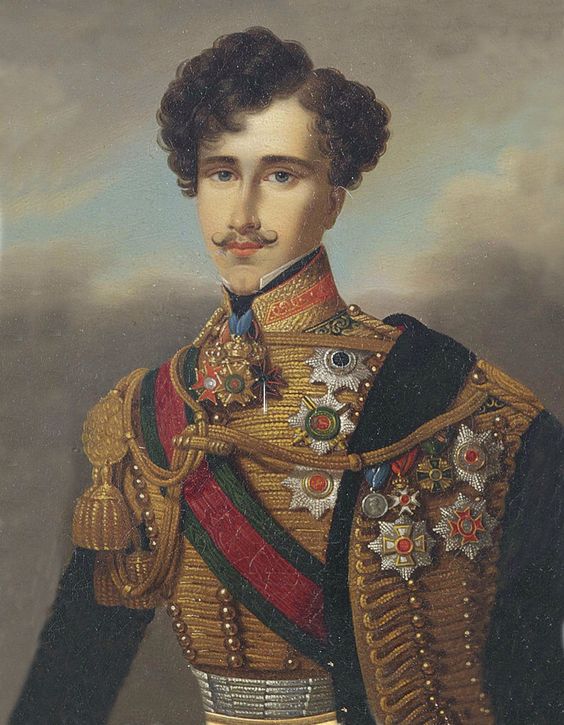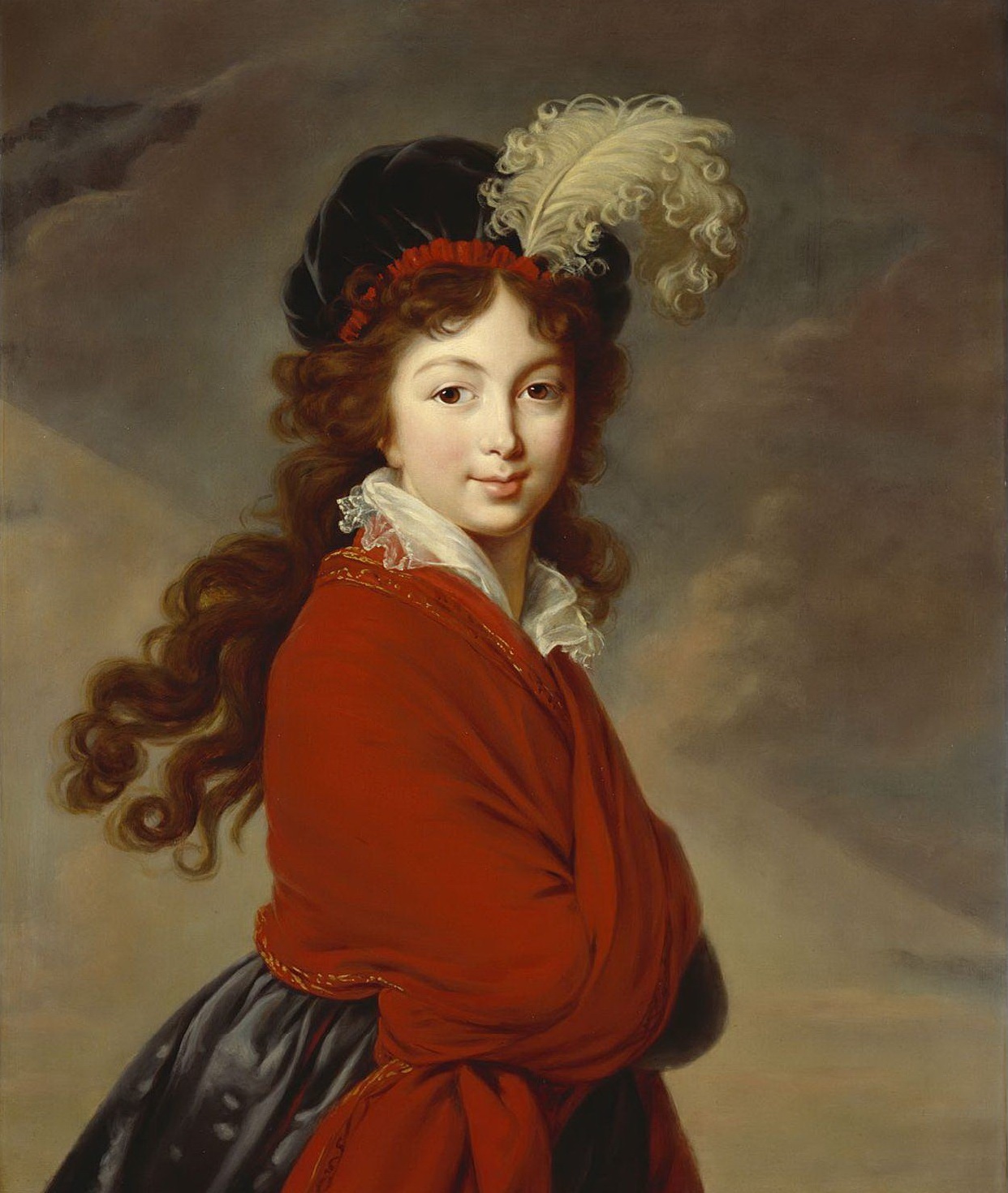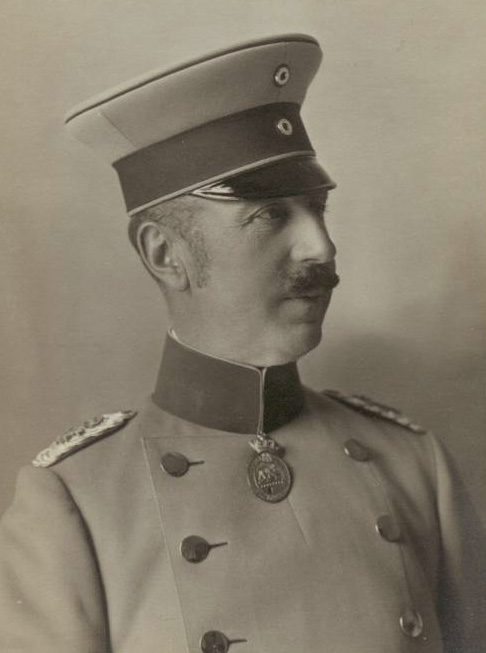by Susan Flantzer
© Unofficial Royalty 2018
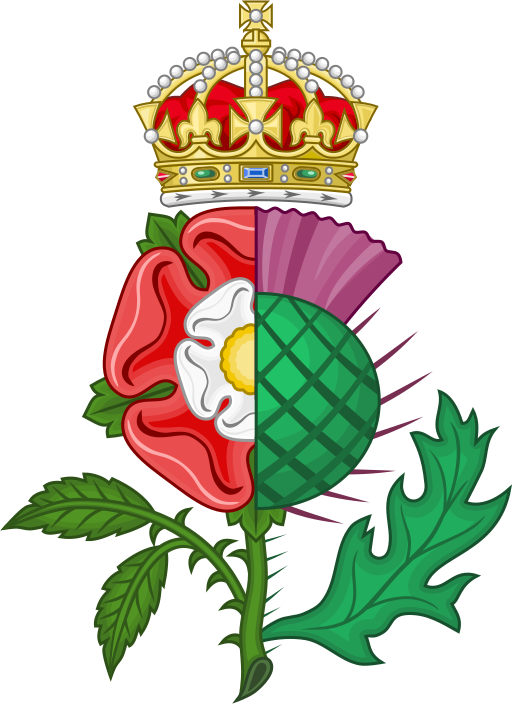
Union of the Crowns Badge Tudor Rose dimidiated with the Scottish Thistle, used by King James VI/I to symbolize the personal union of his realms; Credit – Wikipedia
During the reign of the Stuart monarchs, England transitioned from monarchs who believed in the divine right of kings to constitutional monarchs. In his book The Sickly Stuarts: The Medical Downfall of a Dynasty, Frederick Holmes, a former Professor of Medicine at the University of Kansas Medical Center writes: “While it might be imagined that Parliament grew in strength throughout the seventeenth century because right was on their side and Englishmen were successful in their demand to rule themselves, this, in fact, is only part of the picture, and perhaps the smaller part. In reality, the Stuarts were a sickly lot who were sapped of their strength and vitality by disease and disability during the four generations their six monarchs ruled England. The power of the Stuarts and the English monarchy slowly faded throughout the long seventeenth century as the Stuarts were brought down by a variety of medical problems and Parliament simultaneously increased in power to fill the void.”
Illness, the inability to conceive children, the inability to bring a pregnancy to term, and giving birth to weak children affected the Stuarts’ ability to fulfill the primary duty of a king: to marry and have sons (or even daughters) to succeed to the throne. A look at a short history of the children or lack of children of the six Stuart monarchs will illustrate this.
King James I/King James VI of Scotland
- had seven children
- four died before the age of two
- the eldest and the heir Henry, Prince of Wales died of typhoid fever at age 18
- two survived to adulthood: King Charles I and Elizabeth who married Friedrich V, Elector Palatine of the Rhine and their grandson George, Elector of Hanover succeeded to the British throne upon the demise of the House of Stuart
King Charles I
- had nine children
- three died before the age of three
- Elizabeth died from pneumonia at the age of 15
- Henry, Duke of Gloucester died of smallpox at age 20
- four survived to adulthood: King Charles II, King James II, Mary, Princess Royal (mother of King William III) and Henrietta who married into the French royal family – her Catholic descendants were barred from the British line of succession by the Bill of Rights 1689 which prohibited Catholics from inheriting the British throne
King Charles II
- no legitimate children, it is thought that his wife Catherine of Braganza had at least three miscarriages
- had at least 14 illegitimate children
King James II
- had eight children with his first wife Anne Hyde
- six died before the age of three
- two survived to adulthood: Queen Mary II and Queen Anne
- his second wife Maria Beatrice of Modena had 12 pregnancies, gave birth to five live children
- only two survived to childhood: James Edward Francis Stuart (The Old Pretender) and Louisa Maria Teresa who died of smallpox at age 20
- deposed in 1688, children from second marriage were Catholic and were ineligible for the British throne
Queen Mary II and King William III
- no children, Mary had at least one miscarriage and possibly more
Queen Anne
- had 17 pregnancies but only five live births
- only Prince William, Duke of Gloucester survived early childhood but he died at age 11
**********************
King James VI of Scotland/King James I of England

James I and Anne of Denmark; Credit – Wikipedia
Throughout his life, King James VI of Scotland had close relationships with male courtiers, which has caused debate among historians about the nature of the relationships. However, a marriage was necessary to provide heirs to the throne of Scotland. On August 20, 1589, James was married by proxy to Anne of Denmark at Kronborg Castle in Helsingør, Denmark. Anne was the eldest daughter of King Frederik II of Denmark and Sophia of Mecklenburg-Güstrow, who conducted the marriage negotiations after the death of her husband in 1588. Ten days after the proxy wedding, Anne set sail for Scotland, but severe storms forced her to land in Norway. Upon hearing this, James set sail to personally bring Anne to Scotland. On November 23, 1589, the couple was formally married at the Old Bishop’s Palace in Oslo, Norway. After a prolonged visit to Denmark, James and Anne landed in Scotland on May 1, 1590. On May 5, 1590, Anne made her state entry into Edinburgh, the capital of Scotland. She was crowned Queen of Scots on May 17, 1590, at the Holyrood Abbey in Edinburgh.
The first Stuart King of England got the throne because the Tudors failed to provide for the succession. King James VI of Scotland, the son of Mary, Queen of Scots, succeeded to the English throne in 1603 upon the death of Queen Elizabeth I. James VI was the great-great-grandson of the first Tudor king, King Henry VII of England, through Henry’s daughter Margaret who had married King James IV of Scotland. James VI had been King of Scots since he was eleven months old. He succeeded to the English throne as King James I of England when he was 37 years old. He was already married and five of his seven children had already been born.
**********************
Wedding of Elizabeth Stuart and Friedrich V, Elector Palatine of the Rhine

Elizabeth Stuart and Friedrich V, Elector Palatine of the Rhine; Credit – Wikipedia
Sadly, James I’s eldest son and heir, Henry, Prince of Wales died in 1612 from typhoid fever. James I had planned a Catholic wedding for Henry and had arranged a Protestant marriage for his only surviving daughter Elizabeth to Friedrich V, Elector Palatine of the Rhine and the wedding plans went on as planned despite Henry’s death. There had not been a royal wedding in England since that of Queen Mary I and Prince Philip of Spain in 1554 and never had there been a royal wedding so magnificent and expensive.
The wedding of Elizabeth Stuart and Friedrich V, Elector Palatine of the Rhine, both 16-year-olds, was held on St. Valentine’s Day in 1613 at the Chapel Royal at the Palace of Whitehall in London, England. As the wedding was a private affair and not the large public, royal weddings we have become accustomed to, only the courtiers saw Elizabeth in her magnificent attire. The bride was dressed in a white satin gown with diamonds sewn upon the sleeves. Elizabeth’s hair was plaited down her back to her waist with gold spangles, pearls, and diamonds between every plait. Upon her head, she wore a gold crown with pearls and diamonds. The court celebrated the wedding with days of feasts, sports in the palace tiltyard, and performances of masques. London’s citizens were treated to mock battles between galleons in the Thames by day and fireworks along the Thames at night. No other Stuart wedding would be as grand.
Elizabeth proved to be the most successful Stuart in having children – fourteen children with only one dying in childhood. Her daughter Sophia of the Palatinate who married Ernest Augustus, Elector of Hanover was the mother of King George I of Great Britain, the first monarch of the House of Hanover, and is the ancestress of the current British Royal Family.
**********************
Wedding of King Charles I and Henrietta Maria of France

Charles I and Henrietta Maria; Credit – Wikipedia
With Elizabeth leaving home in 1613, her 12-year-old brother Charles, the heir to the throne since the death of his brother and the future King Charles I, was the only child left at home. As a child, Charles was frail and late in development, possibly from rickets, and could not yet walk or talk by the age of three. He overcame his early physical problems, although he grew no taller than five feet four inches, and learned to ride, shoot, and fence. However, he was no physical match for his stronger and taller elder brother Henry, Prince of Wales, whom he adored.
King James I, seeking a Spanish alliance, had visions of Charles marrying Infanta Maria Anna of Spain, the youngest daughter of King Philip III of Spain. In 1623, Charles went to Madrid with his father’s favorite George Villiers, 1st Duke of Buckingham for marriage negotiations regarding the Infanta. The negotiations had long been at a standstill, and although religion was a stumbling block, it is believed that Buckingham’s offensive behavior was a key to the total collapse of the negotiations.
While Charles was traveling to Spain in 1623, he first saw Henrietta Maria, the French king’s sister and his future wife, in Paris as she rehearsed a court entertainment with other members of the French royal family. On March 27, 1625, King James I died and Charles succeeded him. Since the Spanish negotiations failed, King Charles I now looked toward a French alliance and a marriage with Henrietta Maria was successfully negotiated. Henrietta Maria was the youngest daughter of King Henri IV of France and his second wife Marie de’ Medici. Henri IV had been assassinated in 1610 when Henrietta Maria was still a baby and her brother King Louis XIII had succeeded their father. Charles I and Henrietta Maria were married by proxy on May 1, 1625, on the steps of Notre-Dame Cathedral in Paris, France.
15-year-old Henrietta Maria had stormy weather as she crossed the English Channel on her voyage from France to England. Her ship was tossed by storms for a day and upon reaching Dover on June 12, 1625, she had to be carried to Dover Castle. A messenger was sent to ask Charles I to postpone his arrival for a day so she could recover. The next day Charles I and Henrietta Maria were married at Canterbury Cathedral in Canterbury, England. As his bride was young and had recently left her family, Charles did her a kindness on their wedding night. As the embarrassing bedding ceremony was approaching, Charles elbowed his attendants away, went alone into Henrietta Maria’s bedchamber, and barred the door against them.
**********************
Wedding of Mary, Princess Royal and Willem II, Prince of Orange

Mary, Princess Royal and Willem II, Prince of Orange; Credit – Wikipedia
The first of Charles I and Henrietta Maria’s children to marry was their eldest daughter Mary, Princess Royal. Charles I wanted Mary to marry one of the sons of King Felipe IV of Spain or her first cousin Karl I Ludwig, Elector Palatine of the Rhine but both marriage prospects failed. Instead, Mary was betrothed to Willem, Hereditary Prince of Orange the future Willem II, Prince of Orange), son of Frederik Hendrik, Prince of Orange.
On May 2, 1641, at the Chapel Royal of the Palace of Whitehall, nine-year-old Mary married Willem, who would have his 15th birthday in a couple of weeks. The whole wedding was truly a children’s affair. Mary was led to the altar by her ten-year-old brother Charles (the future Charles II) and her eight-year-old brother James (the future James II). The six bridesmaids were all young girls no older than the bride. Willem wore a velvet suit embroidered with gold thread while Mary wore a white silk dress embroidered in silver. Her hair was tied up with silver ribbons and on her head, she wore a pearl circlet. There were no festivities. The family ate lunch as usual, then took an afternoon walk in Hyde Park and ate supper together. Because of Mary’s young age, the marriage was not consummated for several years. Instead of the traditional bedding ceremony, Mary and Willem simply sat on a bed side by side for about an hour.
Charles I had demanded in the marriage contract that Mary remain in England for several years. However, by 1642, he was dealing with so many political problems that he needed Dutch support. In February 1642, Mary, accompanied by her mother, sailed from England to The Hague in the Dutch Republic. Once in The Hague, Mary was warmly greeted by her in-laws and her paternal aunt Elizabeth, Electress Palatine of the Rhine and some of her children. A second marriage ceremony was held in The Hague on November 4, 1643. By the time Queen Henrietta Maria returned to England in February 1643, England was in the midst of a civil war that would result in King Charles I losing his head in 1649.
**********************
Wedding of King Charles II and Catherine of Braganza

Charles II and Catherine of Braganza; Credit – Wikipedia
While Oliver Cromwell had ruled England as Lord Protector, Charles II, who had been the de jure King since his father’s execution, lived in mainland Europe. After Cromwell’s death, Parliament formally invited Charles, as King Charles II, to be the English monarch in what has become known as the Restoration. Charles II returned to England in 1660.
Catherine of Braganza, the daughter of King João IV of Portugal, had first been suggested as a bride for Charles II in 1645 during the reign of Charles I and again in 1660 when the monarchy was restored in England. Already there were rumors of Catherine’s inability to have children but the newly restored King Charles II was eager to have the £300,000 dowry. The marriage contract was signed on June 23, 1661. Catherine set sail for England in April of 1662 and landed at Portsmouth, England on May 13, 1662. On May 21, 1662, King Charles II and Catherine were married. First, a secret, brief Catholic ceremony was held in Catherine’s Portsmouth bedchamber with only her Portuguese attendants as witnesses. Then, the legal Church of England ceremony took place in the Great Chamber in Governor of Portsmouth’s home. Catherine wore a rose-colored gown covered in lover’s knots made from blue ribbon. Her lace veil was covered with symbols of her new country including Tudor roses.
Catherine was horrified to find out that her lady-in-waiting was Barbara Villiers, Charles II’s current mistress. After the initial shock, Catherine maintained a dignified attitude towards her husband’s mistresses and showed many acts of kindness to his illegitimate children. Despite fathering at least 14 illegitimate children with his mistresses, Charles II had no children with Catherine. It is thought that Catherine did have at least three miscarriages. Despite having many mistresses, Charles insisted that Catherine be treated with respect, and sided with her over his mistresses when he felt she was not receiving the respect she was due.
**********************
William and Mary

Mary II and William III; Credit – Wikipedia
During Charles II’s reign, two of his nieces: Mary (the future Queen Mary II) and Anne (the future Queen Anne), the only surviving children of his brother James, Duke of York from his first marriage, were married. James would reign as King James II for three years after his brother’s death before being deposed in 1688 during the Glorious Revolution.
In 1677, when Charles II’s niece Mary was 15-years-old, it became apparent that Catherine of Braganza, the wife of King Charles II, would not provide a Stuart heir. In addition, Maria Beatrice of Modena, the second wife of James, Duke of York, had two miscarriages and two daughters, one who had died in infancy and one who was sickly and not expected to survive. Mary’s marriage became a matter of dynastic importance for the House of Stuart. The bridegroom her uncle chose for her was William III, Prince of Orange, her first cousin. William was the only child of Mary’s paternal aunt Mary, Princess Royal and Willem II, Prince of Orange who had died of smallpox a few days before his son’s birth. William was fourth in line to the English throne after his uncle James and his cousins Mary and Anne.
15-year-old Mary and 27-year-old William were married on November 4, 1677, in Mary’s bedchamber at St. James’ Palace with only the closest relatives attending. The bride was miserable, the groom acted with cool correctness, the father of the bride was grimly resigned to the marriage, and the stepmother of the bride, who was very pregnant, was in tears at the prospect of losing her stepdaughter. The bride’s aunt Catherine of Braganza tried to comfort Mary saying, “When I came to England I had not even seen the King,” to which Mary replied, “Madam, you came into England, but I am going out of England.” Mary’s sister Anne and her governess Lady Frances Villiers were unable to attend as they were both ill with smallpox. Only the bride and groom’s uncle, King Charles II, was his usual cheerful and tactless self. Upon closing the curtains around the marital bed during the bedding ceremony, Charles II remarked, “Now nephew, to your work! Hey! St. George for England!”
William and Mary made a formal entry into The Hague, the seat of William’s Dutch Republic, on December 14, 1677. Mary soon became pregnant but suffered a miscarriage which may have prevented any successful pregnancies. It is suspected that she had at least two more miscarriages. Her inability to have children was Mary’s greatest unhappiness. Despite their physical mismatch, Mary was quite tall (5 feet 11 inches; 180 cm) and towered over the undersized and asthmatic William (5 feet 6 inches; 167 cm), William adored Mary and Mary was devoted to William. After the Glorious Revolution of 1688 deposed Mary’s father King James II, Parliament asked William and Mary to reign jointly as King William III and Queen Mary II.
**********************
The Last Stuart

Anne and George of Denmark; Credit – Wikipedia
In December 1680, George, The Hereditary Prince of Brunswick-Lüneburg (the future King George I of Great Britain) made a three-month visit to England and rumors were flying that he would become the husband of his second cousin Princess Anne, the future Queen Anne, whom he later succeeded. However, on July 28, 1683, at the Chapel Royal in St. James’ Palace in London, Anne married Prince George of Denmark, son of King Frederick III of Denmark and the brother of King Christian V of Denmark. It was a small, happy wedding as Anne would be able to remain in England. After the ceremony, there was a small family supper and then the traditional bedding ceremony. Even though the marriage was arranged, the marriage was happy and Anne and George were faithful to each other.
Anne became pregnant a few months after the wedding but she gave birth to a stillborn daughter in May 1684. Anne’s obstetrical history is tragic. She had 17 pregnancies with only five children being born alive. Two died on the day of their birth, two died at less than two years old within six days of each from smallpox, and one died at age 11. Anne suffered from what was diagnosed as gout and had pain in her limbs, stomach, and head. Based on these symptoms and her obstetrical history, Anne may have had systemic lupus erythematosus which causes an increased rate of fetal death.
On December 28, 1694, Anne’s sister Queen Mary II died of smallpox. She was just 32 years old. King William III continued to reign alone for the remainder of his life. As William and Mary had no children, Anne was now the heir presumptive to the throne and her son Prince William, Duke of Gloucester was second in the line of succession. However, on July 30, 1700, 11-year-old Prince William, Duke of Gloucester died.
The death of Prince William and the failure of the Protestant Stuarts to produce heirs meant the end of the Protestant Stuart dynasty as the legitimate descendants of King Charles I were either childless or Roman Catholic. The passage of the Bill of Rights 1689 which prohibited Catholics from inheriting the British throne exacerbated the Stuarts’ succession problems. To solve the succession crisis, Parliament passed the Act of Settlement 1701 which secured the Protestant succession to the throne after King William III’s sister-in-law and heir presumptive Princess Anne.
The Act of Settlement 1701 excluded the former King James II (who died a few months after the act received royal assent) and the Roman Catholic children from his second marriage and also excluded the descendants of King James II’s sister Henrietta, the youngest daughter of King Charles I as they were all Roman Catholic. Parliament’s choice was limited to the Protestant descendants of Elizabeth, Electress Palatine of the Rhine, the only other child of King James I not to have died in childhood. The senior Protestant descendant was Elizabeth’s youngest daughter Sophia, Electress of Hanover. The Act of Settlement put Sophia of Hanover and her Protestant heirs in the line of succession after Anne.
Anne succeeded her brother-in-law and first cousin King William III upon his death in 1702 and reigned until her death in 1714. Sophia, Electress of Hanover, the heir to the throne according to the Act of Settlement, had died on June 8, 1714, just six weeks before the death of Queen Anne, and so Sophia’s son became King George I and started the Hanover dynasty.
**********************
Weddings of Stuart Monarchs and Their Children
Like, the Tudors, the Stuarts did not have a lot of weddings. Wedding venues that have official websites or Wikipedia articles will be linked below. Sometimes the city where the wedding took place is known but the actual wedding venue is unknown. Only married monarchs and their married children are listed. Links are to Unofficial Royalty articles for the monarchs, their children, and their spouses. Note that not all the spouses have Unofficial Royalty articles.
James I, King of England/James VI, King of Scots (great-great-grandson of Henry VII) married (1589) Anne of Denmark at the Old Bishop’s Palace in Oslo, Norway
Charles I, King of England (son of James I) married (1625) Henrietta Maria of France at Canterbury Cathedral in Canterbury, England
Charles II, King of England (son of Charles I) married (1662) Catherine of Braganza in Portsmouth, England
James II, King of England (son of Charles I) (1) married (1659) Lady Anne Hyde in Breda, the Netherlands (2) married (1673) Maria Beatrice of Modena in England
Mary II, Queen of England (daughter of James II) married (1677) Willem III, Prince of Orange (later William III, King of England), grandson of Charles I, in the bride’s bedchamber at St. James’ Palace in London England
Anne, Queen of Great Britain (daughter of James II) married (1683) George of Denmark at the Chapel Royal in St. James’ Palace in London, England
This article is the intellectual property of Unofficial Royalty and is NOT TO BE COPIED, EDITED, OR POSTED IN ANY FORM ON ANOTHER WEBSITE under any circumstances. It is permissible to use a link that directs to Unofficial Royalty.
Works Cited
- Ashdown, D. (1981). Royal Weddings. London: Robert Hale Limited.
- Fraser, A. (1979). King Charles II. London: Onion Books Ltd.
- Genealogics.org. (2018). [online] Available at: http://www.genealogics.org [Accessed 2 Apr. 2018].
- Holmes, F. (2003). The Sickly Stuarts: The Medical Downfall of a Dynasty. Thrupp UK: Sutton Publishing.
- Unofficial Royalty. (2018). Unofficial Royalty. [online] Available at: https://www.unofficialroyalty.com [Accessed 2 Apr. 2018]. (Stuart articles)
- Waller, M. (2002). Ungrateful Daughters: The Stuart Princesses Who Stole Their Father’s Crown. New York: St. Martin’s Press.
- Wikipedia. (2018). Main Page. [online] Available at: https://en.wikipedia.org/ [Accessed 2 Apr. 2018]. (for wedding venue and genealogy information)









